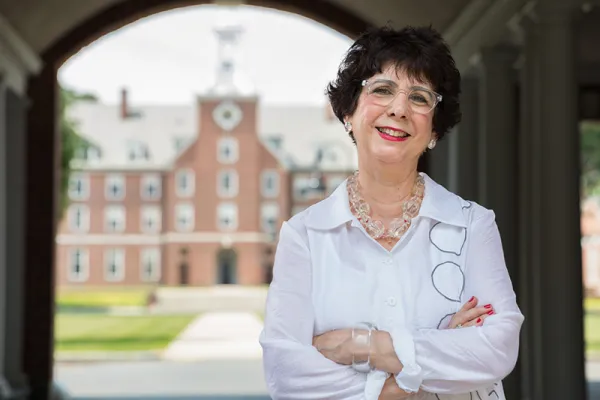Home Sweet Smith: A Conversation with Susan Etheredge
Campus Life

Published September 11, 2018
Susan Puracchio Etheredge ’77 has had years—make that decades—to prepare for her new role as dean of the college and vice president for campus life. She’s twice been a Smith student—first as an undergraduate Italian literature major, and then as a graduate student in the education and child study program, where she also taught as a faculty member for 21 years.
Even her office décor—a collection of Smith College Wedgwood dinner plates she purchased on eBay, a vintage desk found in the basement of Lilly Hall and volumes of student yearbooks—speaks to the long connection Etheredge has to Smith. “This college,” she says, “really has been a home to me for so many years.”
Which is perhaps what makes Etheredge the ideal person to oversee the broad portfolio of all things student related at Smith, from housing to student engagement, athletics and career development.
As part of her role as dean, which she was appointed to in December 2017, Etheredge will lead a new Residential Experience Working Group, made up of students, faculty and staff, charged with conducting a comprehensive study of residential life at Smith.
Central to the group’s work, which will include discussions with students and a survey of best practices at peer institutions, is developing what Etheredge calls a “contemporary definition of home.”
“We want to know what that means for students today,” she says.
Here’s what else Etheredge had to say about meeting the needs of today’s students.
How does your long experience at Smith inform your work with students?
The intellectual excitement and growth I experienced here, the deep friendships I formed, the opportunities to work directly with faculty members—all of these themes that resonated with me as a Smith student are still front and center for the students of today. I find great joy in being able to bring my experience as an alum to bear in conversations with students about life at Smith.
Aside from the year you studied abroad, you lived in one house—Albright House—during your time as an undergraduate. That’s not the experience of all students today, is it?
It’s not. Students tend to move around more now. Our research shows that about 60 percent of students elect to change houses, some more than once. That can be for different reasons: to be with new friends, to try co-op and apartment-style living or to experience a different part of campus.
What else distinguishes students in 2018?
Diversity is a major part of the student experience today. Students’ family structures are smaller and different than they were 10, 20 or 30 years ago, and they bring that home experience with them to college. Social media has provided students with a peek into the lives of so many people, and can create a tremendous amount of pressure to keep up— which in some cases can lead to stress and feelings of loneliness. That’s not just at Smith but at all colleges and universities today.
What do students want from their residential experience at Smith?
Students expect greater choice. In our benchmarking work, we’ve discovered that students are looking for smaller communities; they also want more private spaces and public spaces that can be used for many different kinds of social activities. They are very interested in what some call “interest-based living” around themes or programs or identities, and they have very specific dietary needs and expectations. At the same time, they love our sense of tradition—like Friday teas—and want to hold on to those things.
How is the Residential Experience Working Group you are leading addressing these expectations?
We’re still in the early stages, but we’re considering a number of things, like ways to better engage faculty and staff in the house culture, which is something students want more of. We’re also looking at the dining experience and the possibility of having more flexible dining hours and student meal plans, for example, to accommodate students’ schedules—along with doing more to locally source food and ensure that our entire residential model lives up to our commitment to sustainability.
What excites you most about Smith today?
Students have a remarkable sense of community engagement that I find truly inspiring. Students are here to learn, but they are also here for the life experience. They want to put their knowledge to good use in the world, and I have the privilege every day of thinking intellectually about ways to connect the work students do in the classroom to the work they imagine doing beyond Smith.